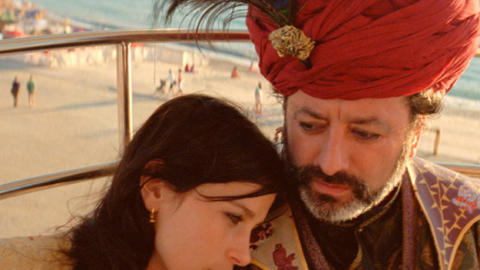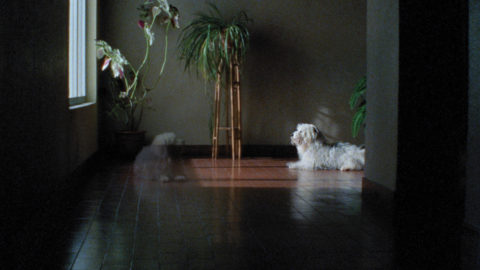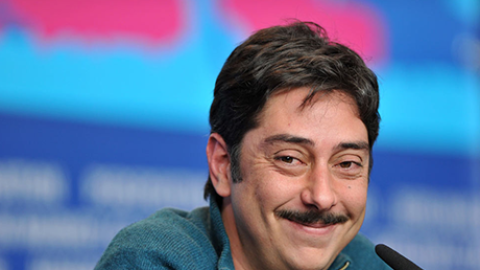Cannes Interview: Miguel Gomes
Arabian Nights, directed by Miguel Gomes, screens this week in The New York Film Festival: Volume 1, The Restless One on September 30; Volume 2, The Desolate One on October 1; and Volume 3, The Enchanted One on October 2. The below interview was conducted at Cannes shortly after the film’s world premiere.
It’s hard to think of another film, much less one addressing socioeconomic strife, that is quite like Miguel Gomes’s The Arabian Nights, comprising three separate volumes that embrace sprawl and variety in style and substance. For (limited) example: dockworkers vent about labor losses documentary-style in Volume One: The Restless One; an alfresco court hosts an absurd chain of grievances and idiocies in Volume Two: The Desolate One; and bird fans engage in song competitions in Volume Three: The Enchanted One. And in arabesque scenes on a mystical isle, Scheherazade herself appears…
Created in reaction to Portugal’s post-crash turmoil, The Arabian Nights is, as Dennis Lim writes in his Cannes coverage in our July/August issue, nothing less than “an up-to-the-minute rethinking of what it means to make a political film today.” At Cannes, FILM COMMENT grabbed a few minutes with Gomes to try and get a handle on this standout of Directors’ Fortnight and, indeed, the festival as a whole.

This movie is kind of crazy—in a good way.
I would say “wild.” That is why I said “OK, let’s rock ’n’ roll!” at the screening. My previous film, Tabu, was much more elegant. This film comes out of a more chaotic situation, which is what’s happening in Portuguese society, but it’s also chaotic because of The Arabian Nights, which is quite a mess. The book is completely crazy. You’re right, it’s a little bit crazy.
With adaptations of literary works, audiences often forget that the original works can be fairly wild too. And with Arabian Nights I don’t think readers had the expectation that the stories would have to be neatly told and all the loose threads cut short.
In fact, what is Arabian Nights? It’s a compilation, a collection of tales from centuries ago. It is based on popular culture, so they are structured in a very wild way. The book—much more than the film—is very scatological, sometimes very violent. It’s completely punk, this book. And because it comes from popular culture, it has very extreme things, very direct feelings, and primal things too. I wanted this film to echo this kind of feeling.
These are also the stories of a storyteller, so they are trying to hold your attention with funny things and shocking things. In the second film, The Arabian Nights, Volume 2: The Desolate One, the court scene is an amazing chain of moments, one surprising bit after another. It’s almost like a sketch show.
Yeah, the fact that it’s a chain, in that case, allowed me to start the film like a comedy and to end it with the sensation of a Greek tragedy. For instance, I don’t know if this exists in America, but there are these songs for children in Portugal and other European countries that are constructed like: “A cat did that…” and then what he did turns into another thing and another thing. And so it keeps accumulating, and the whole song becomes lots of things.

In English there’s a song “For want of a nail…” that ultimately ends “A kingdom was lost.” The guy gets on a horse to tell the king something, but he’s missing a nail in his boot, and so on.
Yeah, like this. That’s a good song. I don’t know it. I like that song.
The humor in the movie is also important, and the satire is especially strong. There’s an undertone of frustration and anger to it—as in the first film, the whole thing about the businessmen with hard-ons. It’s funny, it’s a very blunt conceit, but it’s blunt partly because of the anger behind it.
Of course. It’s also part of the tradition in popular culture to mock the people in power. It exists in every age, in every society, to try to mock them, even sometimes with scatological things. This is very present in Arabian Nights the book. I thought we could also have a place for this in the film. Finally I thought the film had to be so big to have all of this that I said to the producer: “Jesus, I’m sorry but it’s three films. I’m so sorry, but I could not do it otherwise.” Because we had to invent a place for everything. I think that the diversity of the film is what makes it rich. So I had to find a place for the satire, taking a sarcastic approach to the powerful with this idea that these men of power were afraid because they had too much sexual power. This comes from anger, of course, but there are very different kinds of humor in the film.
Humor is a filter that you need. I think a lot about what goes on between the film and the viewer. I started as a viewer, and I still love cinema, and I’m frustrated here at Cannes because I cannot [i.e., don’t have time to] see anything. But one of the things that gets me really mad is when a film is pushing things at me, throwing things in my face, and I cannot do anything. My ability, my power as a viewer is very limited because the film is putting me in a place where I can’t do anything. Humor is very important when you’re dealing with dramatic things, like the kind of reality in this film. It’s very hard in Portuguese society nowadays, and it’s easy to do emotional blackmail with the viewer. Humor is always the filter you can put that will protect the viewer from the dramatic feelings that come out of the film.
But you have to have a balance between all of these things to have a good, honest relation with the viewer. For me, it’s very important to respect the viewer and not say: “OK, I will not do this in the film because it’s very complicated for you.” The best way is to respect the intelligence of the viewer. Of course there will be some people who will not care about what they’re shown. This is life. What is important is to help the viewer, with all the different emotional storms that are within the film.
You also protect the people who are the subject of the film, because you give them many different roles in the movie, not just passive. In the beginning, you have people giving their testimony about problems they’ve had, and you could have done a whole movie that’s just that—people saying that these terrible things are happening. But in the other segments, you have people taking on other roles: a folk hero, for example, or people not at work but in their leisure pursuit, with the finch enthusiasts.
Yeah, we have to show everything. This was very important, in fact, to have a film with such a range. I’m very lucky to have been able to do this film, because I could shoot so much, and so I had the obligation to make different things, to have the unemployed guys talk about their experience of being unemployed. And you feel the weight of this. You feel that they are angry or sad. It’s a difficult situation, but I also have whales exploding, and all of these very different things and characters. You have to have this range to show the complexity of the situation. There is not only one good angle to see things. You have to shift and to change.
This is why for instance [in The Arabian Nights, Volume Two] in “The Owners of Dixie,” the dog story, I have very dramatic situations: a couple commit suicide, people have to ask for charity in order to eat. But you also have another point-of-view: a dog that should be in a Walt Disney film, but he’s in the wrong country and the wrong film. He’s kind of happy! I think the second volume is the most dark of the three, the most desperate. The only character that is happy is a dog because he is not aware of things—everyone is committing suicide, and he doesn’t know about that. He’s just trying to eat and to play with people. I think you also have to have this point of view.
In this I follow the master, Jean Renoir, who said you have to have all points of view of the characters. You have to have all of this in the film because it’s really this that gives you the real scale of things in cinema. I welcome dogs and the rich people and poor people and non-actors and actors and exploding whales.
This raises the question of what you decided to cut. Was there material you didn’t include?
Of course. I was preparing the film, I mean, doing something with the film—shooting, editing, writing, researching, rehearsing, finding locations—for 14 months. During this period, we shot all you see in the film. We didn’t cut any stories, but of course there are scenes that I shot and are not in the film, like in every film I made. Even in a film of six hours, you cannot put everything. For some things, I was not able to do it the right way, or I didn’t find a place to put it in the film. But you get pretty much what we filmed.

Let’s talk about the look of the film. There, too, you see such variety across the three volumes. I was wondering what visual ideas you discussed with your DP, Sayombhu Mukdeeprom.
I’ll tell you about Sayombhu. I think he has some kind of mental disorder, which I love because he was crazy enough to agree to come to Lisbon and live there for more than one year to shoot a film, when I told him: “I don’t have a script, so I don’t have any idea what I’m going to shoot. What I want is for you to be available to shoot, and we don’t know when will be the moments when we are really going to shoot. We have to live there all the time.” I was astonished when he said: “OK, I’m coming.” I said: “OK, you’re crazy.” He said: “Maybe, but I like this idea.” He was great. I have to thank him. He’s very, very good working with natural light. He can do everything.
He accepted the idea that the film would be a patchwork where you could not have an established look. We knew the film would be formed by very different things with very different moods. So what we could do was to relate between a certain moment in the shooting and the characters that we have to shoot, the locations, and try to get in the mood for that kind of a film. In the court scene, with the three moons and the different colors, that was a moment where we created on the set a different kind of lighting that has nothing to do with the workers at the beginning—nothing to do.
Sayombhu and I share something: we are very pissed with the idea of being obliged to shoot on digital. For him, it’s very important, and so he was excited by the idea to keep shooting on 35mm and 16mm. We had anamorphic lenses to shoot on ’scope on 16. That means you have a little bit less definition in the image, and the grain becomes a little bit bigger. We loved the idea of having the ’scope format—the scale for epic films, the thing you do for Ben-Hur. So, doing Ben-Hur, but in a lo-fi way. The lo-fi feeling, of course, is attached to the stories that Scheherazade is telling and the situation in Portugal—more lo-fi, a more poor kind of image. The only thing we shot in 35mm is the sequences with Scheherazade in Baghdad, to make a distinction—like in Tabu, where the first part is in 35 and then the past in Africa is 16. Here, it was 35 for Scheherazade. We talked about doing it in 70mm. I’m glad that we didn’t. It was too expensive and the camera is very, very heavy, so it would have been difficult for us. I’m glad because in France, the lab that worked with 70mm shut down during the shooting process.
The premise of Scheherazade’s song is that she’s telling stories to stay alive. I was curious how you would answer that: why do you keep on telling these stories? What’s your reason?
Because I think that the reality in the last few years in Portugal was very, very hard for everyone. I think that in order to stay alive, we have to tell stories. We cannot renounce fiction. We cannot renounce the possibility of saying things in very different ways. And it seemed very important to tell stories about Portugal and about Portugal nowadays with this range—and to do it, to do it. Because if we are silent, we are dead. Making films is my way of not being silent. That’s my way to react to the situation.






